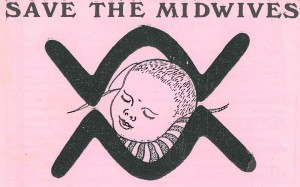 Valerie Fleming records in her 1994 doctoral research Partnership, power and politics: feminist perceptions of midwifery practice (pp. 16-17) that the Save the Midwives Association began in Auckland:
Valerie Fleming records in her 1994 doctoral research Partnership, power and politics: feminist perceptions of midwifery practice (pp. 16-17) that the Save the Midwives Association began in Auckland:
[It was] founded in 1983 to challenge the Nurses Amendment Act which was then in draft form. This Association consisted mainly of consumers but also some midwives. From its beginnings, the aim of the group was to emancipate midwifery from domination by the medical and nursing professions through the development of direct entry midwifery education programmes.
Save the Midwives Association rapidly gained national support and served to unite hospital and domiciliary midwives, both of whom were threatened by the proposed legislative changes (refer pp. 7-12). The Home Birth and Save the Midwives Associations worked together and raised awareness amongst the general public of the abilities of midwives to practise according to the World Health Organisation’s (1966) definition of a midwife (refer Appendix One) which had been adopted by the International Council of Midwives in 1972.
Save the Midwives Association communicated with its growing number of members through regular newsletters which exhorted its members to lobby women’s groups in particular, as it was these which the Association’s executive believed would have the most influence on women in childbirth. The tactics of this group were also successful, as women’s groups took up the cause of midwifery and, in turn, lobbied Members of Parliament to recognise the potential contribution that midwives could offer women.
The Home Birth and Save the Midwives Associations were two of the most politically active groups in raising the profile of midwives but other groups such as Parent Centre and the Domiciliary Midwives Society, too, assisted in helping midwives achieve their independence. Midwives themselves were also active and through their structures were trying to overcome the obstacles which had previously prevented independent practice.
Newsletters
No. 1 (missing)
Save the Midwives, No. 4, Spring 1984
Save the Midwives, No.7, Winter 1985
Save the Midwives, No. 8, 1985
Save the Midwives, No. 9, February, March, April, 1986
Save the Midwives, No 10, 1986
Save the Midwives, Nos. 11 & 12, Summer 1986-1987
Save the Midwives No. 13, Autumn 1987
Save the Midwives, No. 14, c.1987
Save the Midwives, No. 15, May 1988
Save the Midwives, No. 16, August 1988
Save the Midwives, No. 17, Summer 1988/1989
Save the Midwives No. 18, Autumn 1989
Save the Midwives No. 19, Winter 1989
Save the Midwives, No. 20, August 1989
Save the Midwives, No. 21, Summer 1989/1990
Save the Midwives, No. 22, February 1990
Save the Midwives, No. 23, May 1990
Save the Midwives, No. 24, Spring 1990
Save the Midwives, No. 25, Summer 1991
Maternity Action/Save the Midwives, No. 26, Autumn 1991
Maternity Action/Save the Midwives, No. 27, July/August 1992
Maternity Action/Save the Midwives, No. 28, July/August 1993
Maternity Action/Save the Midwives, No. 29, March/April 1994
(Nos 13,18 & 19 provided by Carolyn Young and numbers 14 & 24 suplied by Liz Jull)
| Accession no. |
WWAT 2000/1 |
| Accession title |
Anne Sharplin, Further papers relating to domiciliary midwifery and home birth, 1982-1997 |
| Folder title | Save the Midwives newsletters |
| Holdings location | Wise Woman Archives Trust (Inc.). Available at wwat.nz |
You may also be interested to read Waikato Home Birth Association Newsletter/Newsmagazine
